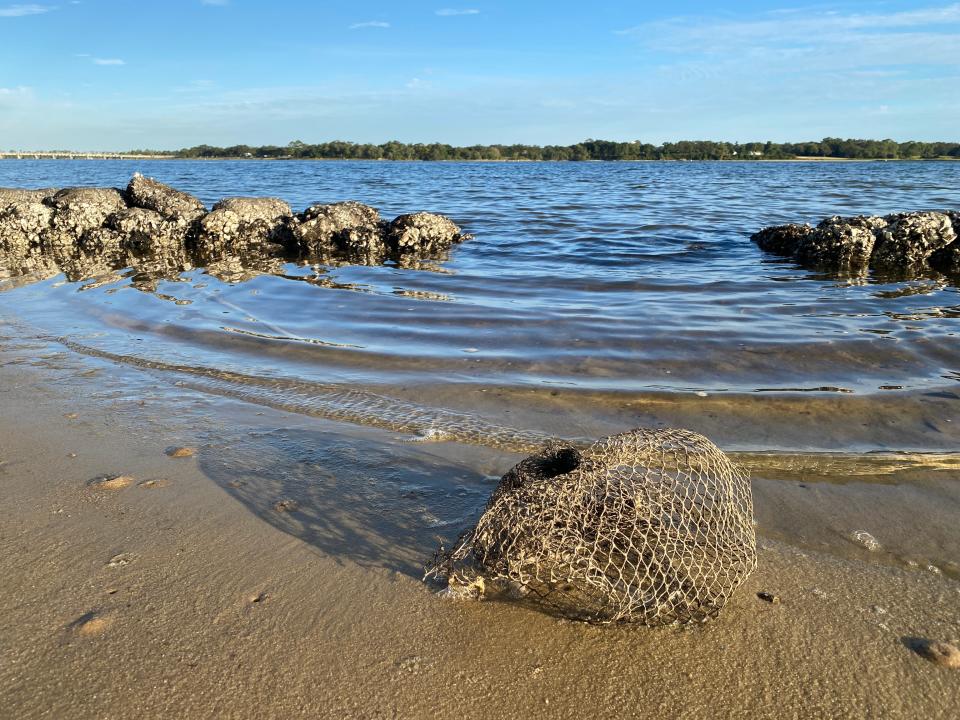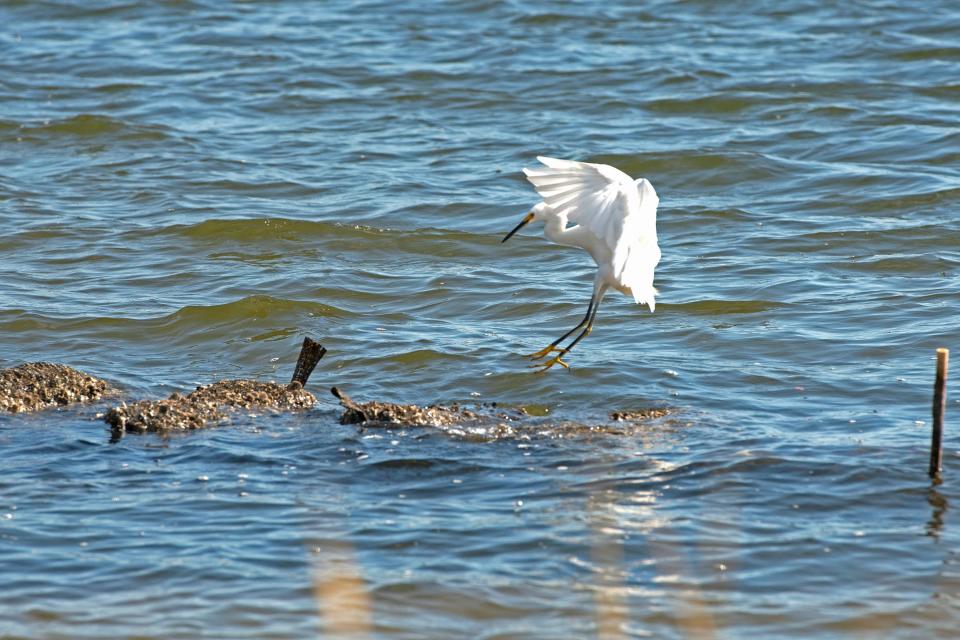Living shoreline in Navy Point appears to be crumbling. Should county repair or remove it?
A new environmental assessment of Escambia County's Navy Point Living Shoreline Project is raising questions about the effectiveness of the project, which appears to be crumbling into Bayou Grande and scattering oyster shells along the second-largest county-owned beach.
Deputy County Administrator and Natural Resources Director Chips Kirschenfeld told the News Journal on Wednesday that his department is looking to hire a consultant who will conduct town hall meetings and provide three alternatives to improve the current conditions at Navy Point.
In 2017, Escambia County began a project to put about 35,000 bags of oyster shells into 87 reef structures along 2,000 feet of the coastline of Navy Point Park in the waters of Bayou Grande in Warrington.

Troubling trends: Contamination could make large chunks of NWFL waters off-limits for oyster farming
Previous coverage: Navy Point living shoreline project draws strong feelings, most of them positive
Latest living shoreline project: White Island once had thriving ecosystem. Living shoreline plan seeks return to glory days
How did Escambia County's Navy Point Living Shoreline Project start?
The project was funded with a $180,000 grant from the National Fish and Wildlife Foundation. The county billed it as a "living shoreline" project meant to prevent beach erosion and improve the water quality of the Navy Point area.
Navy Point resident and local activist Melissa Pino initially supported the project in the early phases and even helped put bags of oysters on the first reef structure, but she soon soured on the project when she saw what it was doing to the neighborhood beach.
For the last several years, Pino has often spoken out against the project and tried to organize an opposition group as it was being built.
Pino has said the reef structures are dangerous to anyone wading into the water as the oyster shells can be razor sharp, and at high tide, the reef structures are completely submerged, marked only by plastic tubes placed into the sands around the reefs.
During an extremely low-tide last week, Pino and Navy Point resident Kevin Wade captured the bottom structures of the oyster reefs on video. The video showed the terrible state of the reefs as the bags appeared to be falling apart.
A look at the Navy Point project engineer
Pino recently hired David McGehee, an ocean engineer who owns Emerald Ocean Engineering, to do a professional assessment of the Navy Point project, which was provided to the News Journal.
McGehee was an engineer on the Pensacola Bay Living Shoreline project and worked as an inspector of coast projects for the U.S. Army Corps of Engineers.
McGehee's report said many of the reef structures installed by the county are structurally failing as the reefs have started to come apart under the wave action in the bayou and settlement of the sand. Many of the bags containing the oysters have ripped open, scattering the sharp oyster shells along the water's edge.

McGehee said the reefs need new oyster growth to become structurally sound.
"The longer-term fate of the structure is essentially up to a race between oyster growth on one hand and wave damage and settling," McGehee wrote. "So far, the oysters appear to be losing."
McGehee also evaluated aerial photos of the area since the project was installed and said the project appears to have provided little overall protection from erosion.
"The longer-term trend of the upland shoreline behind the sandy shoreface is continued erosion because this type of structure provides sporadic short term but no significant long term shore protection," McGehee wrote. "It is more likely to accelerate overall erosion of upland shorelines than reduce it."
McGehee told the News Journal that living shorelines can work great in the right location, but after evaluating the project, he believes the county made the wrong choices regarding that section of shoreline.
"This project was the wrong style of structure using the wrong materials in the wrong location to provide any meaningful longterm shoreline protection," McGehee said.
Chips Kirschenfeld told the News Journal he read the report. He said overall he thought the report was neutral and that a consultant is more likely to tell a client what they want to hear.
Kirschenfeld did acknowledge problems with the project, however, saying the reef structure should be viewed as infrastructure that will require periodic maintenance.
"Any infrastructure project needs maintenance, whether it's a road or bridge or a living shoreline project, and we recognize that," Kirschenfeld said. "We've told the Board of County Commissioners that we need to do maintenance on the project."
Kirschenfeld said the county estimated the project has lost about 2% of the 35,000 bags of oysters, about 700 bags. He said the bags can break down from ultraviolet light from the sun, or that fish or other animals chewing on the bags may rip them open.
"In the last five years, there's been a lot of new research and a lot of new developments with living shoreline projects," Kirschenfeld said. "They are very, very popular. There are hundreds of similar-type projects around the country, and there's new technology and new ways to design and build them."
Funding has increased for projects like Navy Point Living Shoreline Project
Tim Day, senior natural resources manager at Escambia County, told the News Journal there are a lot more funding opportunities for these type of projects today than there were five years ago, and that gives the county an opportunity to fix the shortcomings with the project.
"The stability of (the reefs are) fully reliant on (live) oysters being there," Day said. "We've seen periods where they've been mostly encrusted with oysters, and recently we saw a pullback in the oyster population."
Day said the goal of the county is to improve the Navy Point coastline with green infrastructure.
"There was never a goal to suddenly have oyster shells spread all over the place," Day said.
Kirschenfeld and Day said the county would hire a consultant to develop a plan to use the latest research and input from the community to develop a new plan for Navy Point.
Pino said she believes Kirschenfeld has ignored the problems with the project and anything other than removal would be a waste of taxpayer money.
"The time for public input was long before thousands of bags of sharp shells were ripping apart, and the project badly increased the erosion it was supposed to address," Pino said. "As the recent videos show, the piles are in the process of collapsing and need to be removed in their entirety — and in all due haste — before the next storm."
The Escambia County Commission is set to discuss the status of the project at its meeting Thursday evening.
Jim Little can be reached at jwlittle@pnj.com and 850-208-9827.
This article originally appeared on Pensacola News Journal: Pensacola living shoreline project: Report questions effectiveness

